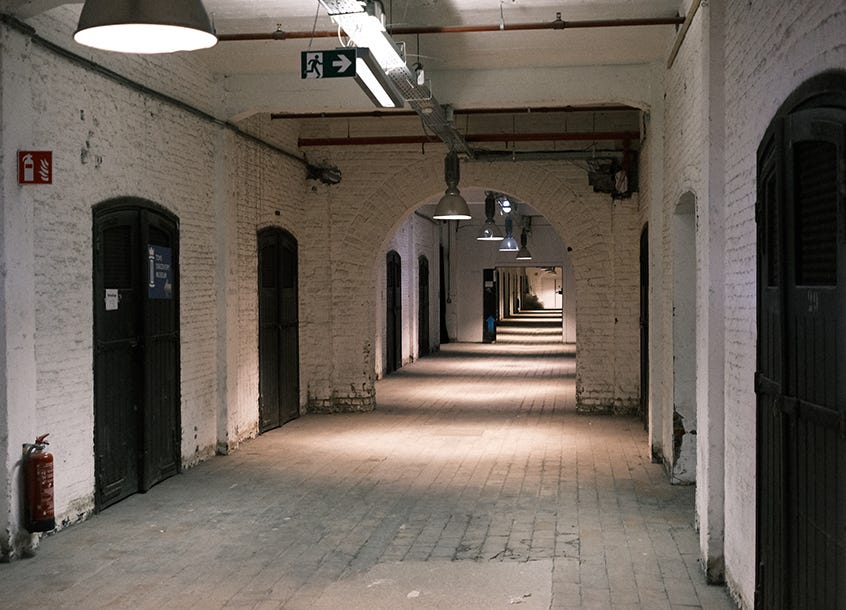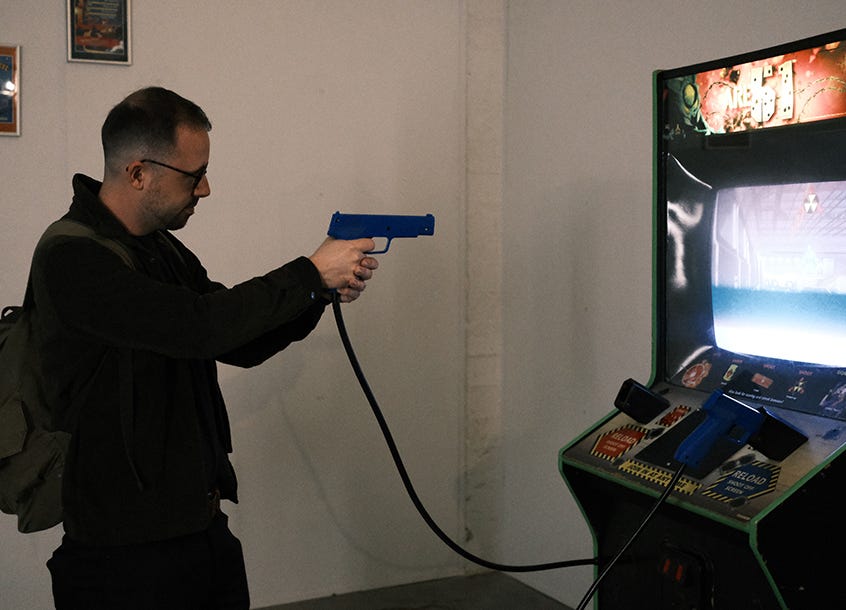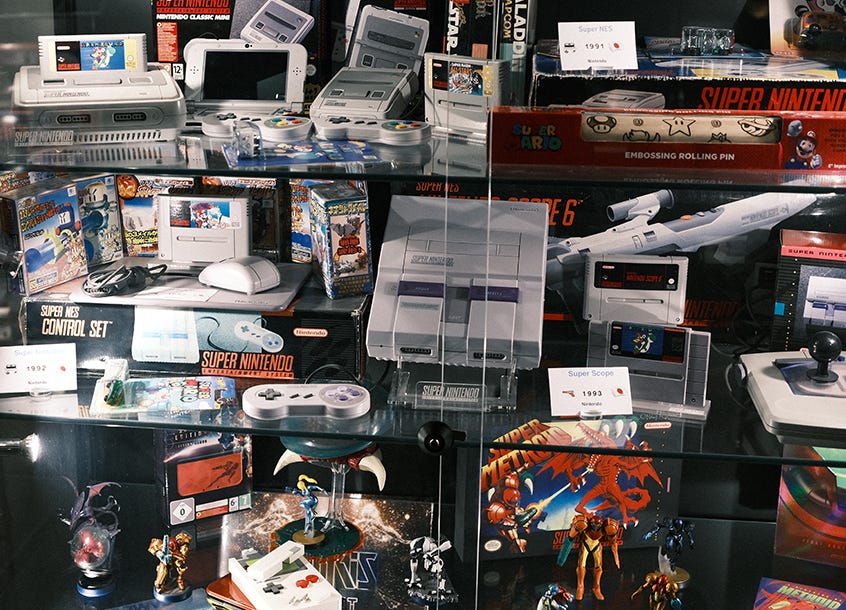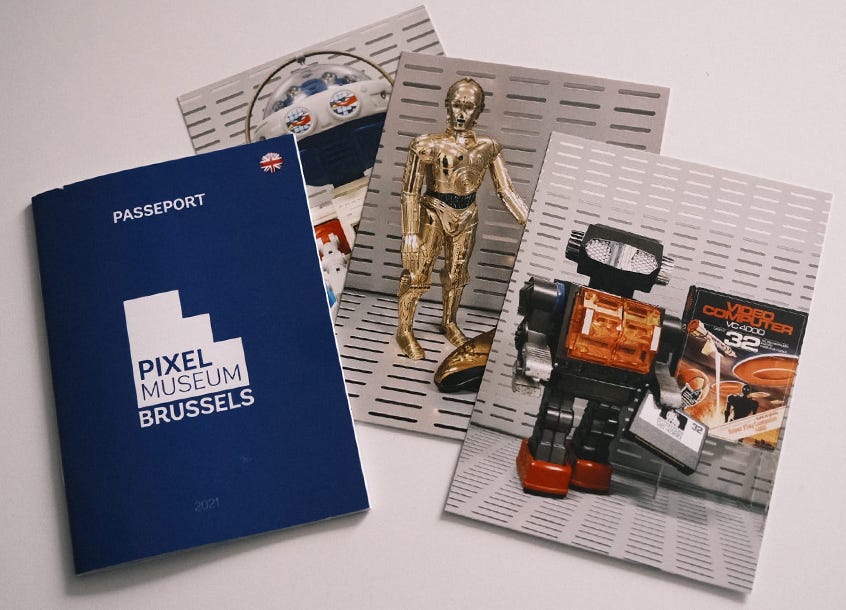This is based on an extract from a post from 2023 where Lottie and I went to Belgium for a few days. These post are mostly focused on our adventures, but while there, we made a point to visit the Pixel Museum in Brussels, and while I touched upon it in the original post, I wanted to create a separate one with a little more depth, and without the extraneous travel stuff. If you’d like to read about that trip though, you can do so here:
*Sadly it appears the museum has since shut down, at least as of April 2025. Hopefully it'll reopen at some point in the future…*
Being a silly gaming enthusiast, aside from all the wonderful landmarks I was looking forward to visiting in Brussels, the foremost for me was the Pixel Museum, and after a lovely walk across the city on our first day there, crossing cobbled streets and canals, we found ourselves at a very expensive gallery of shops. This perplexed us somewhat and for a while we thought we had arrived at the wrong place. That was until we realised the museum was in the basement of the building - I wasn’t sure what I was expecting, but I suppose a basement for a gaming museum is appropriate. I also wasn’t sure what I expected to see upon arriving, and judging by the rather humble entrance, I thought the museum would be rather small and our visit would be rather brief.
Not so. The museum is both comprehensive and vast. Exhibits date from the early seventies and detail the earliest developments in gaming, looking at videogames through the generations, ending with the most contemporary modern day releases. Amongst the computers, games consoles, figurines, and other pieces of promotional and collectable ephemera were playable arcade cabinets, former demonstration consoles, and a variety of other opportunities for gaming, and while I hoped this might be the case, it was a absolute joy to behold. Many of these setups represented hours spent in shops fawning over the newest releases of the time, and the arcade machines were always a rare indulgence in my youth for the severe lack of spendable pound coins. Penny machines were less fun but always seemed to be the value option during my childhood, and it was a fortunate day indeed if I got to play the likes of House of the Dead, Daytona USA, or Time Crisis.
It was a wonderful moment indeed then when I discovered a working Area 51 cabinet, and the pleasure was intensified ten-fold upon realising that it had been modified to be entirely free to use. Playing this old game was rather eye-opening actually, as I realised how much of a hole there was in my day-to-day gaming fun, and the shape of that hole was a perfect silhouette of a Lightgun. Arcades introduced me to the fun of shooting things on screen with the use of a prop, but it was my copy of Time Crisis 2 on the PS2, and the included GunCon 2 that showed me just how much fun I could have at home when it came to gaming, and it wouldn’t cost the world! It was a wonder to be able to retry upon death, as many times as one would like. This of course took the sting out of the challenge somewhat, as well as the mystique of the latter levels, but a price worth paying for the endless hours of enjoyment. Another such example of this was when I got a flight stick (a 4Gamers Flight Sim Stick) for my Gamecube and I realised the potential of Rogue Squadron II, and for my PlayStation, getting a racing wheel (Gamester Dual Force) to make the most of Ridge Racer Type 4. The pleasurable pastime of shooting things on a screen was taken from me in the HD era however as it likely was with many others. I upgraded to an LCD telly and while there were undeniable benefits from this upgrade, I was crestfallen to discover that my Lightgun no longer worked with it. Advancements in technology it seems sometimes leaves treasured loved ones behind. The Wii, and I suppose the Kinect (although I never had one), and probably a bunch of other platforms and systems offered a comparable workaround to this problem, but none seem so good. VR probably offers an equal or even superior experience, but I can’t afford that… probably can’t afford a decent CRT either these days.
You can probably tell that we spent a little longer with the arcade cabinets than the rest of the exhibits… It’s a rare treat to go to an arcade, and an even rarer treat to have infinite goes. Luckily the museum was very quiet at the time we went, so we weren’t holding anyone else up. After we had gotten our fill of shooting, we continued our browsing, taking in the sights. Each console has its own special display, and housed alongside them were various special editions, variations of the consoles, the most iconic releases of the era, as well as bits of gaming ephemera associated with the generation.
These cabinets were akin to portals in time, capturing the spirit and excitement of each console’s reign. As well as this, it was an education in the myriad of strange peripherals that were released with each platform, as well as the odd variety of machines that populated the world of gaming during its chaotic beginnings. Much of what was on show was new to me, and some of the weird creations almost boggle the mind. As well as the displays, you can, around half way through the museum, see the archive room. This is housed within a glass enclosure, and is essentially just a bunch of shelves, but each one is brimming with games. I don’t know quite how extensive their collection is, but it’s incredibly impressive to see so many games in one place. A library of videogaming (albeit one you can’t take anything from…).
After getting our gaming fill, we parted via the gift shop, and I was pleasantly surprised to find a selection of games, books, and trinkets available for sale. The games were rather reasonably priced, and there was quite a decent variety in stock. Nothing that I desired for my collection, unfortunately, but it’s a good place to go if you’re in the area and are looking for something you might not usually find elsewhere.
After a last little browse, and after picking up some postcards, we departed the Pixel Museum with a greater appreciation for games, their history, and their preservation. It showed me a little of what I had missed in gaming as the years have progressed, and it was a rather nostalgic trip through gaming as a whole, and an education in everything related to videogames that occurred prior to my entering into the world of games around 1996. We both felt rather satisfied with our experience at the museum and we thought that it was a rather fair twelve euros per adult to enter (as of 2023), and for all the exhibits, knowledge, artefacts, and interactions on offer, it was an experience we’d both recommend.
As we left, having my love of lightgun games reignited by my playing of the Area 51 cabinet, my thoughts were consumed by something that I had seen in the past - something that I hadn’t investigated further since first seeing it some years ago. This was the Sinden Lightgun. When coming back from Brussels I investigated a little, and found that, to my delight, not only was Sinden still going, but there are a handful of other light gun variants, all of which are striving to revive the peripheral. Since then, I had intended to acquire one to test it out for myself, and to bring a bit of arcade magic back to my home, but they are just that little bit too expensive at the moment to pull the trigger, so to speak. Still, my intentions remain, and hopefully in the not too distant future I’ll be able to try one for myself.
As always, thank you for reading. If you’d like to support the blog, you can do so by subscribing and sharing!



























